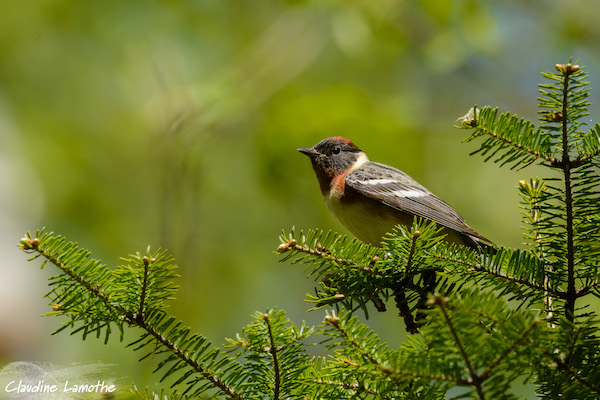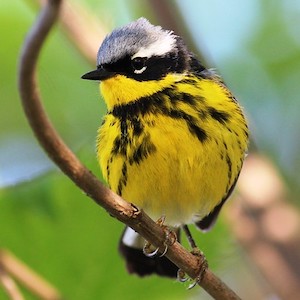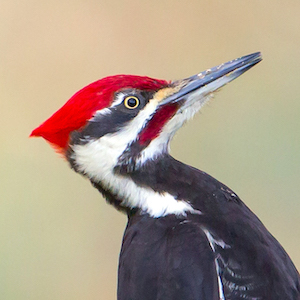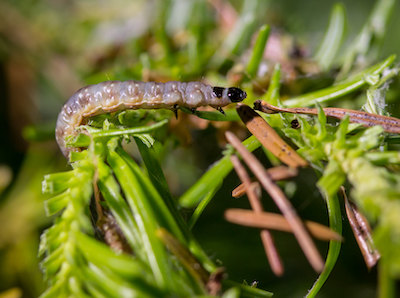
A 6th instar spruce budworm larva. Photo by Paul Williams/Flickr.
Most of the time, eastern spruce budworms (Choristoneura fumiferana) go unnoticed by humans. Modest populations of this small, well-camouflaged native moth “fly under the radar” so to speak. Its larvae feed on the needles of balsam fir and white spruce (and occasionally red and black spruce) without making much of a dent. But every 30-40 years or so, spruce budworm populations explode in what scientists call an “outbreak.” Swarms of millions of migrating spruce budworm moths can literally be seen on radar and strike fear in the hearts of foresters.
Outbreaks last about 10 years and can span millions of hectares of forest. These massive and dense populations of budworms can defoliate their host trees year after year, eventually killing them. While spruce budworms and their outbreaks are a natural part of the forest ecosystem, they are a headache for trees and for foresters. Being able to detect an outbreak in its early stages would help forest managers. That is where the birds come in.
Budworm outbreaks are a forester’s nightmare but a warbler’s wildest dream. Protein-packed larvae dripping from every branch? What could be better from a breeding insectivorous bird’s perspective? Three warbler species- Tennessee, Cape May and Bay-breasted -are such big fans of spruce budworms that they are known to scientists as “budworm-linked warblers.”

Rusty coloration indicates conifers damaged by spruce budworm defoliation. Photo by Paul Williams/Flickr.
In a recent paper in the journal Ecological Indicators, Jeanne Moisan Perrier along with colleagues from the University of Quebec, Mount Allison University and IBP Biologist Peter Pyle, investigate whether these budworm-linked warblers can be used to detect an outbreak in its early stages, before it is detectable by aerial or ground surveys. In addition, they looked at which warblers- young adult birds or older birds- are found at emerging outbreaks.
The researchers looked at the abundance of Cape May, Tennessee, and Bay-breasted warblers in relation to spruce budworm density in 75 study plots in the forests of eastern Québec. Early in an outbreak, spruce budworm larvae occur in relatively low densities that increase over the course of the outbreak. They found that the density of all three warbler species increased as the density of spruce budworm larvae increased, but Bay-breasted Warbler numbers went up earlier in the course of an outbreak than the other two species. Also, most of these early-outbreak Bay-breasted Warblers were second-year or SY birds- yearling adults that had hatched the previous breeding season. There were no age-effects detected in Tennessee or Cape May warblers, but the sample sizes in these species were smaller.
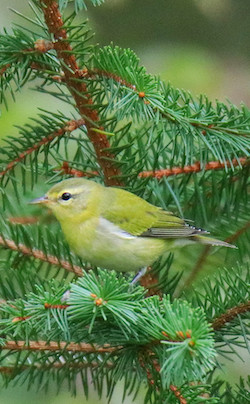
Tennessee Warbler. Photo by Mark Moschell/Flickr.
The age effect in Bay-breasted Warblers makes sense because songbirds typically do most of their dispersal during their first year of life. To avoid inbreeding, second-year birds usually don’t breed particularly close to where they hatched, but once they have found a good breeding territory they will return to it year after year. So these SY birds are more likely to immigrate to a newly emerging spruce budworm outbreak, where larval densities may be lower but will increase dramatically over the course of the warbler’s breeding life. In this study, Moisan Perrier and her colleagues not only found that SY birds dominated in sites at early stages of budworm infestation, but that older after-second-year (ASY) birds moved fairly extensively to track high budworm abundances, a more flexible dispersal strategy than that of other wood warblers.
IBP biologist Peter Pyle aged the warblers in this study using photographs taken by his co-authors out in the field. “Examining how yearling vs. older birds select habitat for breeding and contribute to population demography is an important yet very poorly known aspect of avian ecology,” says Pyle. “One of the reasons for the lack of study is the difficulty in ageing birds in the field, especially females.” Birds like these warbler species are typically aged by looking at feather wear and coloration and applying knowledge of molt cycles. It takes training and lots of practice to age birds accurately and, for many ecologists, that’s not their area of expertise.

Cape May Warbler. Photo by Dennis Church/Flickr.
But it is certainly one of Pyle’s areas of expertise. “Along with most warblers, Bay-breasted, Cape May and Tennessee warblers usually replace all greater coverts but no other wing or tail feathers during the preformative molt after fledging,” says Pyle. “The best ways to age both male and female SYs, therefore, is by the contrast in quality and wear between the brown juvenile primary coverts and the replaced formative greater coverts, and by the pointed shape and worn condition of the outer primaries and rectrices. SY males of all three species also are duller in body plumage than ASY males, and Cape May Warblers show different patterns in wing coverts replaced during the preformative and the first prealternate molts.” Identifying yearling birds has led to important insights into habitat recruitment of Boreal-forest passerines, as documented by a separate study by Pyle and others.
High quality digital photography allows bird ageing experts like Pyle to be consulted even if they aren’t along for the fieldwork. And increasingly, digital photography may allow scientists to age birds from afar, without having them in hand. “With training and practice I think researchers can begin to accurately age birds without needing to catch them, which will greatly expand the potential for studies examining the ecology of yearling vs. older birds.”
For now, forest managers in eastern North America may want to brush up on their warbler identification and long lens photography skills. Documenting Bay-breasted Warblers, especially second year birds, may well provide an early warning sign that a spruce budworm outbreak is brewing.
(If you are interested in spruce budworm-linked warblers, this research group recently published another paper on this topic. Read it here: Site-infidelity by budworm-linked warblers at the edge of an area defoliated by spruce budworm.)


